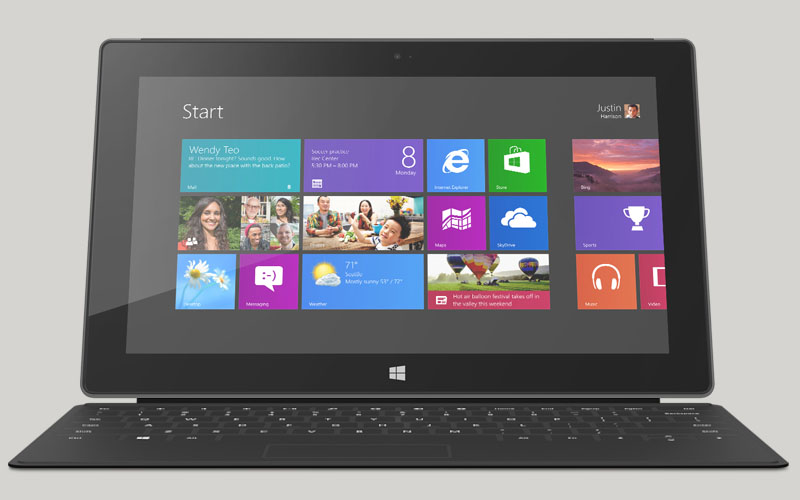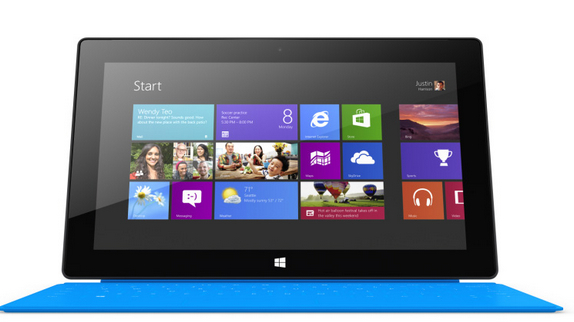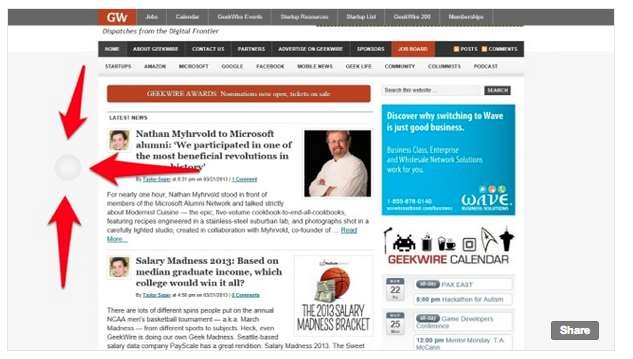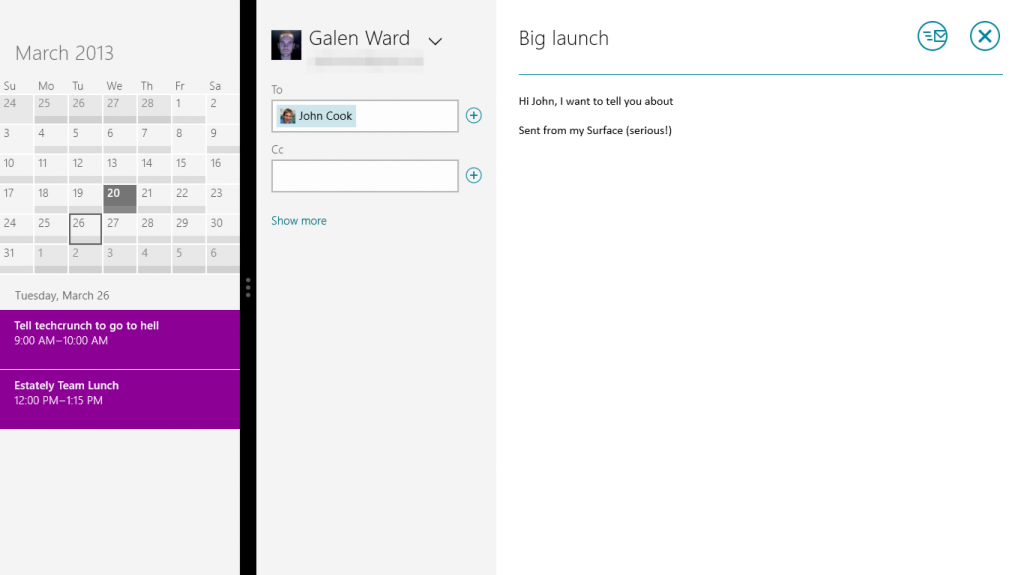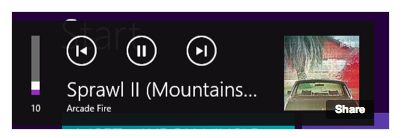Microsoft made a bold bet to build its own hardware, competing directly with Apple's iPad, but it was never an easy task to create something new and unique. Microsoft's own tablet is the result of it facing a "big challenge" relying on its hardware partners to create a high quality physical device that could go up against Apple. Project "Georgetown," the codename for Surface RT, started with two simple goals: the tablet couldn't leak and it must ship when Windows 8 is ready. "The goal was, you gotta bring Windows 8 to life," says Microsoft's Panos Panay, general manager of the Surface team. Looking at the vision of Windows 8 and other Microsoft products, Panay was tasked with creating a tablet that would encompass everything Microsoft had to offer. After months and months of prototyping and tweaking, the end result was unveiled to the world on June 18th of last year. These are a few of the concepts and prototypes that led to that final product.
Secrecy was essential; Microsoft didn't want to upset its OEM partners at a time when it was working to bring Windows 8 to the market. After the project was commissioned by Windows chief Julie Larson-Green, Panos Panay started to form a team of 12 people to tackle the task of creating a vision for what would become Surface. Panay previously worked on Microsoft's PixelSense table (formerly known as Surface) and slowly grew the Surface team from 12 people to 30 people, then on to 80 people and beyond.
"When we started and kind of all the visions were coming together, it was clear we were gonna go make a tablet," he reveals in an interview with The Verge recently. Despite the clear guidelines on a tablet, Panay admits "there were some other concepts, and there were a number of them beyond just tablet at the time," suggesting that Microsoft had considered other form factors. The exact timing of Surface development is still a mystery though, and Panay refused to comment whether the iPad was available before work started on Surface. The official timing statement is that the Windows 8 design vision was locked before the iPad and that Apple's tablet validated a lot of the vision for Microsoft's new operating system.
The Surface tablet started with the concept that people should be able to do more than competitor tablets. Recounting how it all began, Panay explains "we're Microsoft, let's be proud of that, let's be proud that we help people get stuff done." The primary goal was to get the product thin and light to be used as a tablet, with 3D printed prototypes and concepts helping to form the idea of a tablet. Early concepts included rounded backs and edges, but Microsoft settled with a flat back and angled edges to prevent users from feeling like they were about to drop the tablet.
"We stressed out about it."
Microsoft also wanted to protect the tablet with a cover, but enable full productivity. "We stressed out about it," explains Panay, then the team paused and looked at what it had been doing with mice and keyboards for the past 30 years. The Surface team put a magnet on its concept to figure out if it was possible to make a removable keyboard cover. "What ended up happening was we kinda found this idea of everyone needs a cover, so the cover has to be super thin and they're gonna protect their glass which is an important concept and we're like, 'let's figure this out.'
After several concepts and prototypes, the team settled on Touch Cover and Type Cover, with separate groups working on both. The goal, in plastic form, was 4.5mm, but it turned out the team was able to push this to just 3mm. "This was literally how do we make something thin enough that looks super cool and feels nice on the hands," explains Panay.
"We're Microsoft, let's be proud of that, let's be proud that we help people get stuff done."

Panay and the team then watched it evolve from one concept to another, before a final design was formed. From the pictures below it's clear to see how many Surface and Touch Cover revisions that Microsoft went through. From yellow covers to flat plastic ones, a number of ideas were thrown around in the process of making Touch Cover what it is today. "We don't have yellow, we don't have any green," he explains. "We get a lot of requests for colors. It's all in the works, we can create colors and special editions," says Panay, revealing that we'll be seeing a number of new covers in the future. The team has previously hinted that it may also be working on battery equipped covers, but Microsoft has nothing to announce in that area just yet.
Microsoft's Surface Pro, codenamed "Georgetown X," started three months after Surface RT. "We started Pro three months after we started RT, that's how the product shipped," says Panay. Explaining the gap, Panay says "it really was people, availability, time," not a delay or product issues. Pro was all about speed with an aim to make it a full PC. "So you still want it to be a device that looks elegant, looks beautiful, something you're proud of, but it's not a museum piece." Museum piece or not, Pro combined the idea of touch, PC, and stylus into a 2 pound package. Microsoft says it designed Surface Pro from the inside out to ensure the weight was evenly distributed for note taking and tablet use. "It's distributed, to a science, it's distributed in a way that takes iteration and it takes a lot of time."
Microsoft's Surface Pro tablet was codenamed Georgetown X
The Surface Pro started shipping in mid-February and Panay says "demand is higher than we initially intended for Pro to be, no doubt." The initial supply issues seem to be mostly resolved, with devices available in stores and online. Reflecting on the launch and reaction to Surface, Panay says the team feels great about what they're doing. "The people that aren't using the products certainly have opinions, but the people using them love them and I think that's what's most important to us right now."
So what's in store for Surface in the future? Panay says the team is working on future Surface generations at the moment. "When I say generations, not just one, we have the teams at full speed and loving what they're building and seeing," he says enthusiastically. "I think things just keep getting better, just hopefully what you'd expect from us."
Hint: Use the 's' and 'd' keys to navigate
-

The father of the Surface handles the original concept for Microsoft's tablet.
-

The first prototype was built with string for the kickstand and a plastic mold.
-

Panay explains that even the prototype had to have strong magnets for the cover concept.
-

Microsoft wanted the Surface to be protected using its cover and to take the form of a book you could easily carry.
-

The final prototype of Surface, complete with the future Touch Cover.
-

The concept sits alongside Surface Pro, showing how it progressed to reality.
-

Panos Panay stares at the Surface he helped create.
-

Some additional molds and another concept for Surface with a curved back.
-

Panos Panay handles one of the first 3D printed Surface concepts.
-

Microsoft tried a number of different concepts and colors for its Touch Cover, including this one.
-

This particular cover concept is flat plastic without any ridges for the keys.
-

The inner workings of Microsoft's keyboard cover.
-

Microsoft uses a sturdy frame for Surface, which is placed together to form its Vapor MG casing.
-

A handful of concepts for the Surface and its Touch Cover.
-

Microsoft went through a number of variations for the Surface look and feel.
-

Some early concepts involved curved and tapered off edges for Surface.
-

Microsoft ended up selecting a flat back without these curves to avoid the sensation of feeling like you'd drop the device.
-

One early Touch Cover concept without the full key formation.
-

This Touch Cover never made it to market, but it was one of the many ideas for a keyboard cover.
-

Microsoft 3D printed the Surface a number of times to get the size it wanted.
-

Microsoft keeps all of its Surface concepts in a secure box.
-

Engineers use a Surface with its chipset exposed to test sound quality.
-

The brains behind the operation, the Surface Pro innards.
-

A professional mic picks up noise in the anechoic chamber.
-

Tests run on the Surface Pro.
By Tom Warren
















